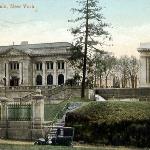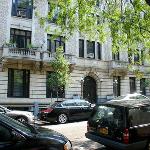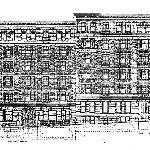The Evenlyn Holding Company...purchased from Louis Gersten, the Cortez, located at 625 West 156th Street, adjoining Riverside Drive and overlooking the Spanish Church, an eight-story apartment house, on a plot 65 by 10, having two apartrments of nine rooms and three baths on a floor, renting for $36,000 and held at $250,000.
New York Times
January 16, 1923
The opening of the museum of the Hispanic Society without fuss or fanfare means a good deal more than appears on the surface...It is merely the visible result of many years of preparation for a line of actions always well calculated, definitely foreseen, and slowly carried out by a vigorous intellect sustained by a more than ordinary allowance of this world's goods.
New York Times
January 19, 1908
It stands in the northern part of Manhattan not far from the Hudson on the one side and Broadway on the other, facing northward on 156th Street. Approach is through lofty iron gates, up broad granite stairs to a terrace whic is reach by magnificent flights right and left. The building stands well back and leaves a broad space of tiles in front. From the doorway one sees the Hudson and Pallisades to the left and in front a number of villas in Audubon Park surrounded by trees, so that it is hard to realize one is in noisy New York.
New York Times
January 19, 1908
Cortez (625 West 156th Street)
Across the street, is another example of the Beaux arts style, the eight-story Cortez, designed by Neville & Bagge and constructed in 1910 at a cost of $250,000. Again, you will see a two-story limestone base with a brown brick façade rising from it. The Cortez may not have had a Riverside Drive address, but the original apartment layout was impressive: two apartments per floor, each having nine rooms and three baths.
As you continue up the street, pause a moment just past Nuestra Señora de la Esperanza and inspect the stone formations visible through the fence. This piece of undeveloped terrain is the only piece of undeveloped land left within Audubon Park’s borders and the only spot where we can say with confidence, "Audubon stepped here." (You can see the spot from another angel on the Audubon Terrace Plaza.)
Hispanic Society (north building)
The original entrances to the Hispanic Society and Nuestra Señora must have made a grand spectacle along the south side of 156th Street. In the center of this block, a broad staircase rose from the sidewalk to a wide landing where it split into a double- staircase leading up to the museum plaza. A gated iron fence between stone pillars separated the museum from the street, but left the view open to the apartment buildings opposte. The looming back of the Hispanic Society’s north wing now stretches across that space, its plain, institutional surface separating the museums from this street, symbolically cutting them off from the neighborhood and literally obscuring the splendid view. Fortunately, the double staircase still survives as part of a sculpture court just off of the museum plaza.
Goya and Velazquez (605 & 611 West 156th Street)
Turning your back to the unattractive wall of the Hispanic Society’s north building, focus your attention across the street on one of the two sets of twins in Audubon Park, the Goya and Velazquez.. Architects Denby & Nute designed these six-story twins in a “modern Renaissance” style. In 1910, each cost $175,000 and originally contained twenty-nine apartment of four-to-eight rooms.
Continue up the street to Broadway. Just before the corner, you will see an arched entry with lion’s head brackets on either side that support a cornice and ornamental iron balcony. Above the door is a keystone cartouche. That is Hispania Hall, one of the second pair of twins; you will examine the other in a moment. When you reach the corner, turn and look back down 156th Street for a moment, then turn left and cross the street.
 | ||||
 | ||||
Hispanic Society Entrance (Original)
(click to enlarge)
 | ||||
Goya and Velazquez
Architectural Rendering
(click to enlarge)
Velazquez
(click to enlarge)
Continue your walk . . .
Funded by the Audubon Park Alliance


